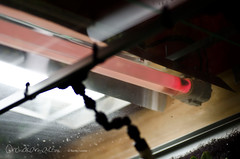 This is what happens when good lights go bad… or at least when you wire them up badly. They eventually burn out and die. So after about a year and a half I had to bite the bullet and rebuild all four lights for the cool vivarium. Because one after one, they had all started to give me trouble this fall. Light being an absolute key ingredient in vivarium culture, this was serious business.
This is what happens when good lights go bad… or at least when you wire them up badly. They eventually burn out and die. So after about a year and a half I had to bite the bullet and rebuild all four lights for the cool vivarium. Because one after one, they had all started to give me trouble this fall. Light being an absolute key ingredient in vivarium culture, this was serious business.
It all started with one of them not coming on sporadically. I figured I might have a bad ballast, so I ordered a new one and replaced it. But no dice. The light would still refuse to come on intermittently, and when it did come on the light would glow ominously red for the first 15-20 seconds or so before getting warm and the ends of all the lamps were slightly blackened for the first 5-10 cm. After a few more weeks of this it failed to come on all together. If I would tap the ballast it might flicker a little bit, like it wanted to come on, but soon it would do none of that either. Then the remaining three lights would begin to act up as well. I knew it was just a matter of time before they would all fail, so I really needed a plan for how to fix this… and fast!
I still cannot find any factory made fixtures for these lights, and I really don’t understand why? My fixtures are crude and home-made, so I guess it does not come as a complete surprise that something would go wrong. I tried talking to the local electrical shops, but they had no clue what so ever… I tried searching on the internet high and low for advice. Dear husband even tried rewiring all the lights for me, but no luck!
Then I remembered getting some really nice help from the UK lighting store where I bought my replacement lights for the growing window earlier in the year. So I wrote them a fairly confusing email asking for help. I was desperately hoping they might be able to figure out what the problem was. To my surprise, and great relief, I actually did get a reply with a solution. Turns out I had been given bad advice on how to wire them up initially, that on top of being sold the wrong kind of wire eventually lead to this complete failure.
Apparently the blackening at the ends showed that the lamps had lost most of their emitter material and that none of them soon would start. The million dollar question question was of course why. Apparently there were two likely scenarios… either the electrical connections from the ballast were wrong, or there might be a faulty lamp holder – or the connections (the wiring) between the ballast and lamp holder were wrong or loose. I am betting money it is the latter, bad wiring – not faulty equipment, since I had four light all failing more or less at the same time. Since each switching on/off cycle causes sputtering of emitter material, the lights have just burned out prematurely. The recommendation I got was to replace both the lamp holders (luckily not very expensive) as well as the lamps. They even included some of the correct wire, free of charge, so I could wire it all up correctly this time.
Originally I was told to wedge the wired in the slots on top of the ballast, which I always felt was a bit strange as they did not seem to get very good contact… turns out they really needed to go into the holes underneath (finally got an answer out of Osram despite not being a professional electrician). The large stranded wire that I was originally using would not fit there, but the new wire would! It is about half as thick, and a single copper wire instead of the difficult to work with stranded kind. Much better!! That also meant having to wire up the pigtail (the plug providing the electricity from the wall) using the new wire and a grounded electrical junction box. Easy as pie! Dear husband helped me wire the lights back up with new lamp holders and brand new Dulux 80W lamps (he’s quite handy to have around that man), and voilà! All lights are now up and running again and it looks like a solarium in there, he he…
Thank you Paul from CP Lighting, you are a life saver! By the way, I warmly recommend this seller. Helpful (above and beyond), good selection and very good prices despite shipping charges to Sweden. I am soooooo relieved I finally got this sorted. It has caused me sleepless nights for weeks, months!
How NOT to wire it up (and the result of when you do it wrong):
















I really admire the passion you have for your orchids, I had never seen that before. Your work is truly inspirating !!
Thank you very much Daniel! That means a lot coming from you. 🙂
Thank you Karma ! I will now avoid burning the whole house…
He he… well, luckily it does not seem to have been all that dangerous, but rather expensive since the lamps only last a little over a year… instead of three years like i had planned. 😉
Hello Karma, I am curious what light level (In foot candles) do you have just below the lights (say 12cm below the fixtures) and what level do you have at the bottom of the vivarium? (I have been very impressed with your whole setup and am looking to replicate your light levels on a vertical garden I recently built.) Thanks!
Hi Darren. Thanks for your nice words on my setup. Good that I can provide some inspiration. 1 fc is = 10.764 lux = 10 lumens per square meter. Each of the 80W lights puts out 6000 lumen, so I get a total of 24000 lumen spread out over 175 cm width and 160 cm depth. 6000 lumen translates to 557 fc, 24000 lumen would be 2229 fc, but of course that is not really accurate and at best only a very crude estimate since the lights are spread out over a wider area not clustered in one place. All these numbers are at 1 meter distance, if you half the distance between the light and the plants you quadruple the light intensity, do the math on that… Sorry, the best info I can get you I am afraid since I do not have a light meter. But I can tell you that I am successfully blooming a lot of low light species (Masdevallia, Dracula, PLeurothallis, Maxillaria etc.) at the very bottom of the vivarium, where light levels are the weakest. 🙂
Thanks Karma, Funny you should mention the light meter as I just purchased one a couple weeks ago in order to evaluate my growing areas. And I must say it was a real eye opener for me – I have discovered just how little natural light I am receiving. (Especially now in winter) I immediately began thinning out some surrounding vegetation that was blocking the light and that has helped some but I clearly see the need for supplemental lighting this time of year. Thanks again for all the info and keep doing what your doing because it is definitely working for you!
Thanks! 🙂 I can totally relate to the lower light levels… we get about 6,5 hours of daylight in Gothenburg this time of year.
Hello Karma, Yeah, have to admire your passion for your orchids! I have some thoughts on your wiring problem. I think perhaps the braided wire should have been
tinned. Tinning is just applying solder to the ends of the wire to make sure all wires in braid make a good connection. At any rate I think the only advantage of the braided wire would be flexibility. Want to say I really love your site and just curious to know which of your orchids you have owned the longest?
Thanks a lot Don. 🙂 The braided wire I had was too thick to do this, I tried soldering it actually and it would not fit in the holes then. Thanks for the advice though! The new wire I got works beautifully now however, I am so happy. It is not quite as flexible perhaps, but it does not have to be.
Hmmm… what orchids I have had the longest..? I had to rebuild my orchid collection when we moved back home to Sweden in 2007 as I did not have CITES for any of the ones I grew in the US. The first orchids I bought then was a handful from a Swedish seller (Åkesson Orkidéer), she imports mainly from Vacherot in France. I remember a Cattleya intermedia v. orlata, Phragmipedium Grande, Paphiopedilum Dellaina and a Masdevallia Aquarius in one of those early orders… all these I still grow on my windowsill. M Aquarius have been blooming non-stop (really) since May 2008, P Grande is just in the process of opening its flowers as we speak, both C intermedia and P Dellaina are in bud right now… a bit late in the year for the Cattleya, but she refuses to rest for me…